Immerse yourself in Bilbao's vibrant flavors and uncover hidden culinary gems with our expert insider guides. Plan an unforgettable trip today!
Read more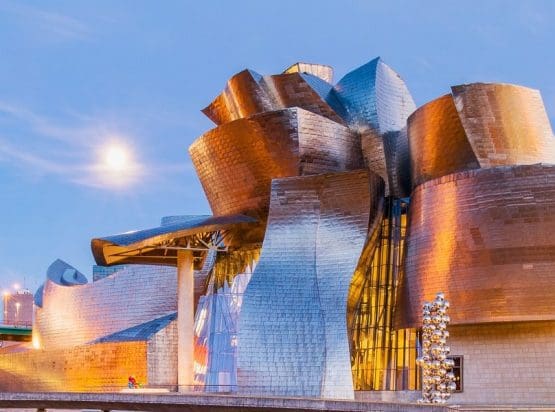
EXPLORE ALL OUR BASQUE COUNTRY WINE REGIONS GUIDE
Last updated: August 6, 2024
The beautiful Basque Country is one of the unsung heroes of Spanish tourism. It’s all here – a dramatic coastline, innovative gastronomy, spectacular mountains, and some of Spain’s most refreshing wines. That’s right: even the inclement climate of northern Spain can turn its hand to wine production. The local tipple is called Txakoli, a light, fruity, zippy, slightly sparkling white wine; heaven served cold and accompanied by anchovies, tuna ventresca, and fish dishes. If you usually err on the side of caution and plump for a glass of Kiwi Sauvignon Blanc, we implore you to try it. Any journey into the glorious pintxo culture of El Pais Vasco cannot omit a glass (or seven!) of this wonderfully zesty and moreish white.
Discover more about Spanish Wine
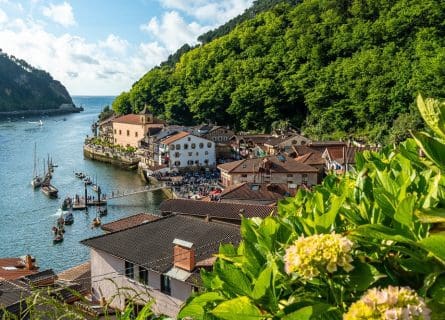
Proud, individualist, and occasionally fiercely patriotic, the Basques will not thank you for describing them as ‘Spanish.’ Indeed, their history has long chartered a different path from the rest of the Iberian Peninsula. Historians and anthropologists believe that the Basque dialect, Euskera, is an ancient language that predates Greek and Latin by several centuries.
Indeed, the language of the Roman conqueror was never adopted in this corner of Atlantic Spain, not least because these inhospitable mountains safely protected the Basques from any foreign influences. As a result, the Visigoths and Moors had little impact on the region’s culture, despite the latter’s rise to prominence in the 8th century after General Tariq launched an invasion in 711.
However, this blissful isolation could not last. As the Catholic monarchs pushed back against the Berber and Arab armies in Spain, they pursued a ‘one nation’ policy of unifying this diverse country into a single state with a common political structure and centralized administration. Yet the mobilized forces of Basque nationalism could not be so easily cowed.
After a prolonged tug of war-, the Basques and their Navarran neighbors extracted a series of autonomy statutes from the Castilian government in the Middle Ages, known as fueros. These old documents and the political independence they awarded remain vital to the debate concerning Basque separatism, even in the 21st century.
This relatively peaceful arrangement lasted for over 500 years. Sadly, the political turbulence of the 19th century saw the fueros rendered null and void as Spain once again pursued a rigid policy of centralization. But in economic terms, the Basque country was thriving. Their economy has long placed the highest importance on tradition; the Basques are deep-sea fishermen, and fish plays a significant role in their imaginative cuisine, regarded by many as the best in Spain.
Yet the region’s capital, Bilbao, was one of the first cities in Spain to industrialize following the development of an iron ore mining industry in the province. Steelworks and factories fueled meteoric growth in the 1800s, causing rapid urbanization and the creation of a burgeoning new middle class.
Vineyard Challenges in the Basque Country
Meanwhile, The region’s vineyards produced large volumes of tart, and low-alcohol wines served in every tapas bar in northern Spain. However, a severe outbreak of oidium (powdery mildew) did untold damage to the wine industry, as the fungus thrived in the humid environment of the Basque Country.
Still, the formation of the Second Republic in 1931 offered Basque nationalists a glimmer of hope. This progressive, democratically elected government offered the Basque Country home rule in 1936, which was taken up by two of the three key provinces. But, unfortunately, their jubilation was short-lived: the dictator Francisco Franco defeated the republic’s forces during the Spanish Civil War, installing an autocratic military regime that endured until the 1970s.
A Castilian nationalist, Franco was unyielding in his views that regional independence was tantamount to treason. Thus, he abolished the fueros and ruled Spain with an iron grip. The region’s wine industry was also put under centralized control, producing utter dross in these dark years.
Thankfully, a great deal has changed since democracy was restored in 1975. The Basques have reclaimed their autonomy over local affairs, while private investment has transformed viticulture. As a result, the region’s Txakoli industry is once again a source of considerable pride. Poured into tall glasses from a great height, it is a vital and colorful part of this unique culture.
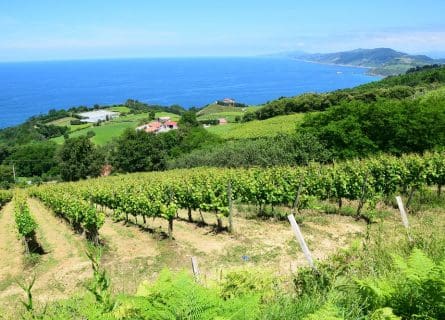
Northern Spain is a strong contender for the most beautiful part of Europe. It boasts some of the most pristine beaches in the world, in addition to undulating scenery replete with hilltop villages, farms, gorges, and verdant fields. The vine is very much at home in this environment, despite the very wet maritime climate of the Basque Country.
Nevertheless, high alcohol and rich textures are almost impossible to achieve in this part of Spain. But the terroir is conducive to delivering a style of white that is totally in vogue: light, refreshing, and very aromatic. The coastal areas and interior are planted to vines, with the coolest sites found in the higher-altitude plots in the hilly terrain south and southeast of Bilbao. Three Denominaciones de Origen (DOs) are within the Txakoli region: Getaria, Bizkaia, and Álava.
Getaria
The Getaria zone was given official DO recognition as recently as 1989, despite a long winemaking tradition dating back to at least the 15th century. Yet in the early 1980s, there were only 21 hectares of vines in Getaria; in 2007, the region was extended to the whole of the historic Gipuzkoa territory. Now there are over 400 hectares under vine.
Bizkaia
DO Txakoli Bizkaia or Bizkailo Txakolina, meanwhile, was established in 1994. Successful vineyards have popped up all over the region (which surrounds the city of Bilbao), sticking to coastal areas, valleys, and the interior. The highest concentration of vineyards is around Urdaibai and Uribe. This interpretation differs from other Txakolis, which is slightly more acidic and has more distinctive herbaceous notes.
Álava
Finally, Txakoli Álava or Arabako Txakolina is an interior region south of Bilbao; only established in 2001, it is the youngest of the three regions. The fresh, humid climate means sugar levels are low in even the best vintages, and the resulting alcohol level rarely exceeds 9%. Perfect for those who seek moderation at lunch!
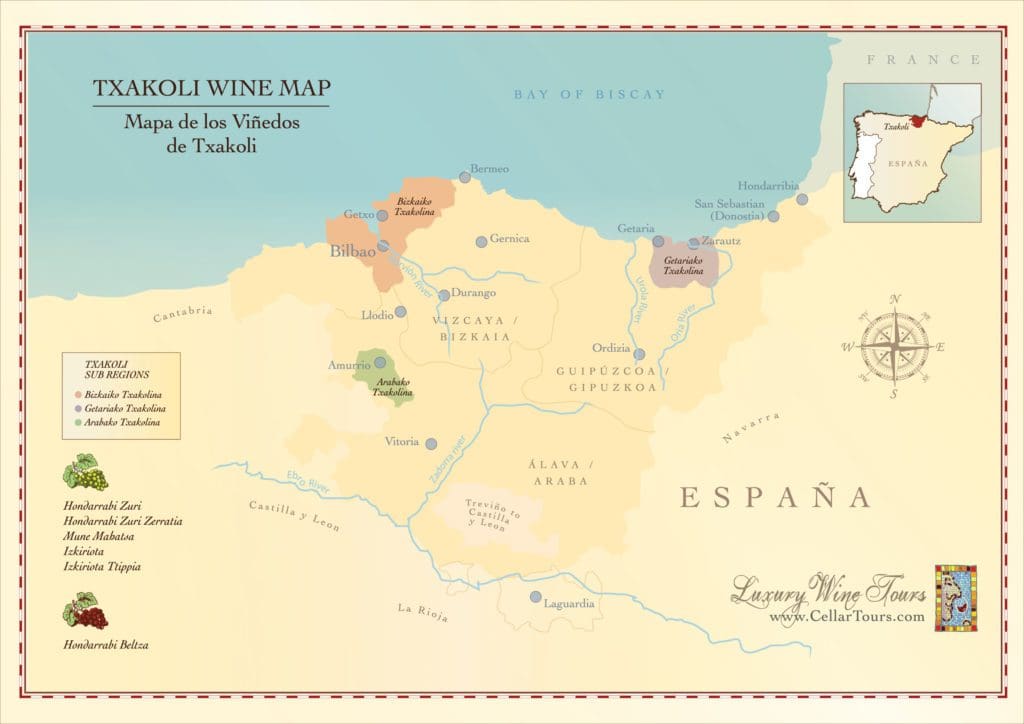
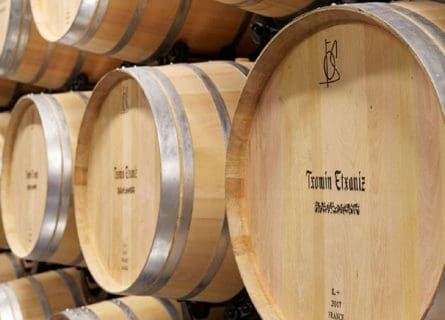
Despite the inevitable consequences of global warming, quality wine production here is still challenging with (relatively) cool summers and high rainfall. However, thanks to the determination of local producers who have striven to conserve traditional cultivation (wire-trained vines of indigenous varietals) with the help of modern vinification practices, the region has grown from strength to strength.
Diversity and Evolution of Txakoli Grapes
The vast majority of Txakoli is built around the zippy brilliance of the Hondarrabi Zuri grape, although the DO rules permit blending in a dash of Hondarrabi Zuri Zerratia (Petit Courbu), Mune Mahatsa (Folle Blanche), and Izkiriotas (Petit and Gros Manseng).
Historically, the winemaking method was extremely rustic: juice was allowed to oxidize and ferment in warm conditions in old wooden containers, producing a stale and acidic style of wine.
Thankfully, the modern paradigm emphasizes protecting the juice at all costs, preserving primary fruit aromas with a cool vinification in stainless steel. As a result, it is common for winemakers to bottle Txakoli on its lees, which encourages a minor secondary fermentation, releasing a small amount of C02 into the wine.
This bubbly spritz makes Txakoli so pleasant to drink in the summer months. In addition, a small volume of red and rosé wine is made in each of the three subregions – the former can rival Mencia in its sappy texture and bright, floral fruit.
Can Txakoli make the leap from local tipple to export giant? It seems plausible: light and low-alcohol categories are hugely trendy, particularly with health-conscious Millennials in wealthy markets like Germany, Scandinavia, the UK, and the US. Moreover, Txakoli ticks practically every box in the sommelier and buyer communities, being affordable, well-made, and delicious. The only problem is a lack of sufficient volume and limitations on planting new vines.
Indeed, local consumption and demand are such that despite their growing popularity abroad, it is rare to find Txakoli Bizkaia wines, for example, outside the region. On the plus side, however, Txakoli can offer diverse styles, including fragrant rosé and elegant reds that work fantastically well alongside summer dishes.
Of course, most Txakolis are white wines designed to be drunk young. However, several producers have successfully experimented with oak barrel fermentation and extended time on the lees, producing fuller-bodied, more structured Txakolis capable of cellar aging and standing up to richer cuisine. With enough effort and a little luck, Txakoli could become an international superstar.
Unveiling the charm of the Hondarrabi Zuri grape. Explore its origins, unique flavor profile, and its role in crafting exquisite Txakoli wines.
Find out moreMune Mahatsa, also known as Folle Blanche, is a grape variety prominently featured in Txakoli wines from the Basque Country. This ancient grape thrives in the region's unique terroir, adding refreshing acidity and delicate aromas to the beloved Txakoli wines. Discover the captivating journey of Mune Mahatsa in the renowned Txakoli wine region, where tradition and innovation blend to produce exceptional vintages.
Petit Manseng is a white grape grown mainly in the South West of France that produces high-quality sweet wines. It's one of France's best-kept wine secrets.
Find out moreThe sauvignon blanc grape varietal, originally from the Bordeaux region of France, is now one of the world's most loved white varieties.
Find out moreDiscover Riesling's charm, a white grape from Germany's Rhine region, cherished in Alsace, France. Unveil its secrets and delights
Find out moreUnveiling the charm of the Hondarrabi Zuri grape. Explore its origins, unique flavor profile, and its role in crafting exquisite Txakoli wines.
Find out more
Welcome to Spain’s foodie capital. Take your pick from a surfeit of Michelin-starred restaurants, irresistible tapas bars, and lively cider taverns. Abundant fresh fish and seafood have long distinguished the cuisine of northern Spain from the Atlantic; Basque pintxos make full use of this wonderful bounty. The region is also a source of great cheeses. But the true magic of eating here lies in the talents of the Basque Country’s formidable chefs. The Basques, with their famous gastronomic societies, have few peers in Western Europe.
Guide to Basque Gastronomy: Read more

Immerse yourself in Bilbao's vibrant flavors and uncover hidden culinary gems with our expert insider guides. Plan an unforgettable trip today!
Read more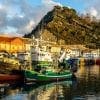
Immerse yourself in Getaria's vibrant flavors and uncover hidden culinary gems with our expert insider guides. Plan an unforgettable trip today!
Read more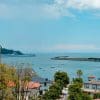
Immerse yourself in Hondarribia's vibrant flavors and uncover hidden culinary gems with our expert insider guides. Plan an unforgettable trip today!
Read more
Immerse yourself in San Sebastian's vibrant flavors and uncover hidden culinary gems with our expert insider guides. Plan an unforgettable trip today!
Read more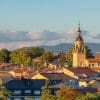
Immerse yourself in Vitoria-Gasteiz's vibrant flavors and uncover hidden culinary gems with our expert insider guides. Plan an unforgettable trip today!
Read moreIf you would like us to customize an exclusive luxury tour, contact us and let us know your travel plans. We offer luxury food and wine tours for private groups of a mininium two guests. In addition, all of our private, chauffeured tours are available year-round upon request.

